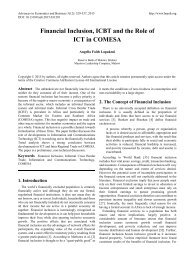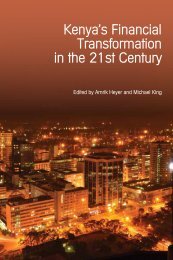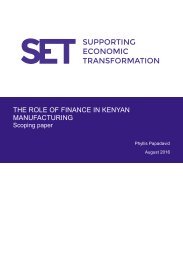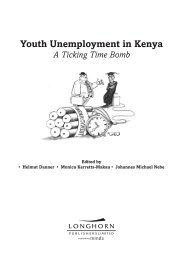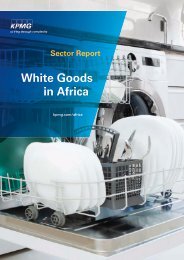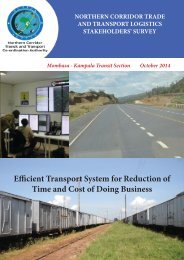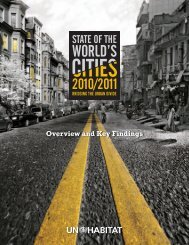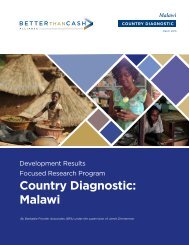FD
gvti301SEaf
gvti301SEaf
You also want an ePaper? Increase the reach of your titles
YUMPU automatically turns print PDFs into web optimized ePapers that Google loves.
AFRICA<br />
These inequities are mirrored elsewhere. According to the<br />
United Nations (UN) Gender Inequality Index, which measures<br />
inequality in the labor market, mortality and fertility<br />
rates, education, and empowerment, many countries in sub-<br />
Saharan Africa—notably Mali and Niger—stand out as having<br />
some of the world’s highest gender inequality.<br />
Income inequality is also high in sub-Saharan Africa. In<br />
the past 15 years, rapid growth in the region has boosted<br />
per capita income, and poverty rates have fallen. But wide<br />
income disparity across the population remains and has<br />
even increased in many countries, making incomes in the<br />
region the most unequal in the world after Latin America<br />
and the Caribbean (see Chart 2). Greater income equality can<br />
encourage economic growth because it increases low-income<br />
households’ ability to invest in education and physical capital.<br />
It can also reduce sociopolitical instability and poor governance,<br />
which discourage private investment (Barro, 2000).<br />
Costly inequality<br />
Given that both income and gender inequality are high in the<br />
region, and in light of global evidence that such inequity hinders<br />
growth, the inevitable question is how much inequality<br />
harms economic prosperity in the region.<br />
The potential harm is substantial, though it varies across<br />
countries. Our research finds that reducing income and gender<br />
inequality to the levels currently observed in the fastgrowing<br />
economies of southeast Asia (Indonesia, Malaysia,<br />
Philippines, Dieterich, 04/27/2016 Thailand, Vietnam) could boost sub-Saharan<br />
Africa’s annual real per capita GDP growth by an average<br />
of close to 1 percentage point a year. This is roughly the<br />
same order of magnitude as the impact on annual per capita<br />
growth of closing the infrastructure gap over the past 10<br />
years between the two regions.<br />
Chart 1<br />
More equality, higher growth<br />
High gender inequality appears to be hindering sub-Saharan<br />
Africa’s growth, even after taking into account each country’s<br />
level of development.<br />
(United Nations Gender Inequality Index and GDP per capita growth not<br />
explained by level of development, 1990–2010)<br />
15<br />
10<br />
5<br />
0<br />
–5<br />
–10<br />
Rest of the world<br />
Sub-Saharan Africa<br />
–15<br />
0 20 40 60 80<br />
Gender Inequality Index (→ more inequality)<br />
Sources: UNDP Human Development Report; World Bank, World Development Indicators;<br />
and IMF staff estimates.<br />
Note: Countries showing growth above zero are growing faster than can be explained by<br />
their per capita income, and those that exhibit growth lower than zero are growing more<br />
slowly.<br />
Our study highlights a number of explanations for inequi-<br />
ties that are holding back sub-Saharan Africa’s growth potential.<br />
Many of these driving forces affect gender inequality and<br />
income inequality similarly. Indeed, gender inequality itself<br />
propels some income inequality.<br />
Our study also confirms that inequality of opportunity—<br />
that is, initial conditions and availability of resources that<br />
help people reach their full economic potential—explains<br />
much income and gender inequality. For instance, lack of<br />
access to education, health care, and basic infrastructure<br />
services can limit human capital development and reduce<br />
productivity. In sub-Saharan Africa, there has been general<br />
improvement, but many countries are still trailing countries<br />
with similar incomes in other regions.<br />
Opportunities for women have generally improved—but<br />
not enough. For example, male and female primary school<br />
enrollment has risen since the turn of the century, driven by<br />
the UN Millennium Development Goals. But only 91 girls for<br />
every 100 boys are enrolled in primary or secondary school,<br />
and only 73 women for every 100 men are at the postsecondary<br />
level. The reasons for these gaps range from lack of basic<br />
infrastructure, which means more time spent (mainly by<br />
females) on household activities to high adolescent fertility<br />
rates and early marriage, which bind girls to household work<br />
at an early age. In Niger, for example, there are more than 200<br />
births for each 1,000 girls ages 15 to 19, and only 15 percent<br />
of girls are enrolled in secondary education.<br />
Similarly, women are behind in access to financial services.<br />
Dieterich, 04/27/2016<br />
The percentage of the population with an account at a financial<br />
institution has increased in recent years, but more so<br />
for men than for women. In some countries, such as Kenya,<br />
mobile-phone-based accounts have overtaken traditional bank<br />
accounts and have helped close the gap between income groups<br />
in access to finance, but the gender gap in access to mobile<br />
money remains high. In Kenya, more than 62 percent of men<br />
Chart 2<br />
High income inequality<br />
Despite strong growth in sub-Saharan Africa, inequality has<br />
fallen little—and unevenly across countries.<br />
(change in Gini coefficient, a measure of inequality)<br />
115<br />
95<br />
75<br />
55<br />
35<br />
15<br />
0<br />
–25<br />
–45<br />
SLE<br />
NGA CPV<br />
ETH<br />
MOZ<br />
UGA<br />
TZA ZMB<br />
BFA<br />
MLI<br />
MUS<br />
NAM<br />
BWA<br />
MWI<br />
ZAF GHA<br />
LSO<br />
SEN<br />
SWZ CMR<br />
KEN<br />
SYC GIN<br />
CAF<br />
NER<br />
GMB<br />
MDG<br />
CIV<br />
BDI<br />
GNB<br />
ZWE<br />
–25 –20 –15 –10 –5 0 5 10 15<br />
Real GDP per capita growth, 1995–2011<br />
Sources: World Bank, World Development Indicators database; and Solt (2014).<br />
Note: Change is between 1995 (or next earliest available year) and 2011 (or latest<br />
available year). Data labels in the figure use International Organization for Standardization<br />
(ISO) country codes.<br />
RWA<br />
Finance & Development June 2016 23




